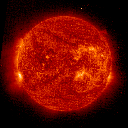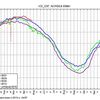Miðvikudagur, 1. apríl 2009
Frétt NASA í dag: Sólin í djúpri lægð...
Í dag birtist greinin sem er hér fyrir neðan á vefsíðu NASA. Þar er fjallað um hegðun sólar sem hefur ekki sést í hartnær öld. Á vefsíðunni segir: "We're experiencing a very deep solar minimum" og "This is the quietest sun we've seen in almost a century"
Allar mælingar sýna það sama: Sólblettatalan, sólvindurinn, heildarútgeislun og útgeislun radíóbylgna sýna svo ekki verður um villst að sólin er komin í djúpa og óvenjulega lægð.
Í tölvupósti frá NASA í dag þar sem vefsíða þeirra er kynnt segir: NASA Science News for April 1, 2009: How low can it go? The Sun is plunging into the deepest solar minimum in nearly a century.
Um þessar breytingar er einnig fjallað í pistlinum 8. janúar: "2008 var næst-óvirkasta ár sólar síðan 1913"
Sjá frétt NASA frá í dag hér fyrir neðan, eða hlusta:
(Myndirnar má stækka með því að tví-smella á þær).
--- --- ---

http://science.nasa.gov/headlines/y2009/01apr_deepsolarminimum.htm?list1078000
Deep Solar Minimum | 04.01.2009 | ||
+ Play Audio | + Download Audio | + Email to a friend | + Join mailing list April 1, 2009: The sunspot cycle is behaving a little like the stock market. Just when you think it has hit bottom, it goes even lower. 2008 was a bear. There were no sunspots observed on 266 of the year's 366 days (73%). To find a year with more blank suns, you have to go all the way back to 1913, which had 311 spotless days: plot. Prompted by these numbers, some observers suggested that the solar cycle had hit bottom in 2008. Maybe not. Sunspot counts for 2009 have dropped even lower. As of March 31st, there were no sunspots on 78 of the year's 90 days (87%). It adds up to one inescapable conclusion: "We're experiencing a very deep solar minimum," says solar physicist Dean Pesnell of the Goddard Space Flight Center. "This is the quietest sun we've seen in almost a century," agrees sunspot expert David Hathaway of the Marshall Space Flight Center. Above: The sunspot cycle from 1995 to the present. The jagged curve traces actual sunspot counts. Smooth curves are fits to the data and one forecaster's predictions of future activity. Credit: David Hathaway, NASA/MSFC. [more] Quiet suns come along every 11 years or so. It's a natural part of the sunspot cycle, discovered by German astronomer Heinrich Schwabe in the mid-1800s. Sunspots are planet-sized islands of magnetism on the surface of the sun; they are sources of solar flares, coronal mass ejections and intense UV radiation. Plotting sunspot counts, Schwabe saw that peaks of solar activity were always followed by valleys of relative calm—a clockwork pattern that has held true for more than 200 years: plot. The current solar minimum is part of that pattern. In fact, it's right on time. "We're due for a bit of quiet—and here it is," says Pesnell. A 50-year low in solar wind pressure: Measurements by the Ulysses spacecraft reveal a 20% drop in solar wind pressure since the mid-1990s—the lowest point since such measurements began in the 1960s. The solar wind helps keep galactic cosmic rays out of the inner solar system. With the solar wind flagging, more cosmic rays are permitted to enter, resulting in increased health hazards for astronauts. Weaker solar wind also means fewer geomagnetic storms and auroras on Earth. A 12-year low in solar "irradiance": Careful measurements by several NASA spacecraft show that the sun's brightness has dropped by 0.02% at visible wavelengths and a whopping 6% at extreme UV wavelengths since the solar minimum of 1996. These changes are not enough to reverse the course of global warming, but there are some other, noticeable side-effects: Earth's upper atmosphere is heated less by the sun and it is therefore less "puffed up." Satellites in low Earth orbit experience less atmospheric drag, extending their operational lifetimes. That's the good news. Unfortunately, space junk also remains longer in Earth orbit, increasing hazards to spacecraft and satellites. Above: Space-age measurements of the total solar irradiance (brightness summed across all wavelengths). This plot, which comes from researcher C. Fröhlich, was shown by Dean Pesnell at the Fall 2008 AGU meeting during a lecture entitled "What is Solar Minimum and Why Should We Care?" A 55-year low in solar radio emissions: After World War II, astronomers began keeping records of the sun's brightness at radio wavelengths. Records of 10.7 cm flux extend back all the way to the early 1950s. Radio telescopes are now recording the dimmest "radio sun" since 1955: plot. Some researchers believe that the lessening of radio emissions is an indication of weakness in the sun's global magnetic field. No one is certain, however, because the source of these long-monitored radio emissions is not fully understood. All these lows have sparked a debate about whether the ongoing minimum is "weird", "extreme" or just an overdue "market correction" following a string of unusually intense solar maxima. "Since the Space Age began in the 1950s, solar activity has been generally high," notes Hathaway. "Five of the ten most intense solar cycles on record have occurred in the last 50 years. We're just not used to this kind of deep calm." Deep calm was fairly common a hundred years ago. The solar minima of 1901 and 1913, for instance, were even longer than the one we're experiencing now. To match those minima in terms of depth and longevity, the current minimum will have to last at least another year.
Above: An artist's concept of NASA's Solar Dynamics Observatory. Bristling with advanced sensors, "SDO" is slated to launch later this year--perfect timing to study the ongoing solar minimum. [more] Modern technology cannot, however, predict what comes next. Competing models by dozens of top solar physicists disagree, sometimes sharply, on when this solar minimum will end and how big the next solar maximum will be. Pesnell has surveyed the scientific literature and prepared a "piano plot" showing the range of predictions. The great uncertainty stems from one simple fact: No one fully understands the underlying physics of the sunspot cycle. Pesnell believes sunspot counts will pick up again soon, "possibly by the end of the year," to be followed by a solar maximum of below-average intensity in 2012 or 2013. But like other forecasters, he knows he could be wrong. Bull or bear? Stay tuned for updates. | |||
Meginflokkur: Vísindi og fræði | Aukaflokkar: Tölvur og tækni, Umhverfismál | Breytt 2.4.2009 kl. 06:53 | Facebook
Um bloggið
Ginnungagap
Ýmislegt
Loftslag
Teljari
Álverð
Sólin í dag:
(Smella á mynd)
.
Olíuverðið í dag:
Nýjustu færslur
- Kínverskur loftbelgur yfir Ameríku, og Amerískur belgur yfir ...
- Vísindavefurinn: Getum við seinkað klukkunni á Íslandi og fen...
- Sjálfstæðisflokkurinn með tæplega 19% meira fylgi en Samfylki...
- Bjarni Sigurðsson harmonikkusnillingur frá Geysi. Fáein orð...
- Hvers vegna valdi Apple ekki Ísland fyrir gagnaver...?
Heimsóknir
Flettingar
- Í dag (27.7.): 0
- Sl. sólarhring: 6
- Sl. viku: 48
- Frá upphafi: 0
Annað
- Innlit í dag: 0
- Innlit sl. viku: 31
- Gestir í dag: 0
- IP-tölur í dag: 0
Uppfært á 3 mín. fresti.
Skýringar
Tenglar
Tenglar
Ýmsar vefsíður
- Efnisyfirlit pistla
- Lofthiti - Sjávarstaða - Hafís - Sólvirkni... Beintengdir ferlar
- Club du Soleil Greinar um samaspil sólar og veðurfars
- Stjörnufræðivefurinn
- Astronomy Picture of the Day
- Climate4you
- Watts Up With That?
- World Climate Report
- CO2 Science
- The Reference Frame
- Climate-Audit
- ICECAP
- The Air Went
- Science Sceptical Blog
- Roy Spencer
- Friends of Sience
- Prometheus
- Öldur aldanna. Sjaldan er ein báran stök - einnig í veðurfari? (2003) Vefsíða ÁHB
- Gróðurhúsaáhrif eða eðlilegar sveiflur í virkni sólar? (Grein í Lesbók Mbl. 20. júní 1998) Höfundur Ágúst H. Bjarnason
- Er jörðin að hitna?-Ekki er allt sem sýnist (1998) Vefsíða ÁHB
Uppskriftir
Ýmsar mataruppskriftir
Myndaalbúm
Bloggvinir
-
 majab
majab
-
 ragu
ragu
-
 amadeus
amadeus
-
 andres08
andres08
-
 apalsson
apalsson
-
 asabjorg
asabjorg
-
 askja
askja
-
 astromix
astromix
-
 baldher
baldher
-
 biggibraga
biggibraga
-
 bjarkib
bjarkib
-
 bjarnijonsson
bjarnijonsson
-
 bjarnimax
bjarnimax
-
 bjorn-geir
bjorn-geir
-
 blindur
blindur
-
 bofs
bofs
-
 brandarar
brandarar
-
 daliaa
daliaa
-
 darwin
darwin
-
 duddi9
duddi9
-
 ea
ea
-
 egillsv
egillsv
-
 einari
einari
-
 einarstrand
einarstrand
-
 elinora
elinora
-
 elvira
elvira
-
 emilhannes
emilhannes
-
 esv
esv
-
 eyjapeyji
eyjapeyji
-
 fhg
fhg
-
 finder
finder
-
 finnur
finnur
-
 fjarki
fjarki
-
 flinston
flinston
-
 frisk
frisk
-
 gattin
gattin
-
 geiragustsson
geiragustsson
-
 gillimann
gillimann
-
 gretaro
gretaro
-
 gthg
gthg
-
 gudmbjo
gudmbjo
-
 gudni-is
gudni-is
-
 gummibraga
gummibraga
-
 gun
gun
-
 gutti
gutti
-
 haddi9001
haddi9001
-
 halldorjonsson
halldorjonsson
-
 halldors
halldors
-
 hlini
hlini
-
 hof
hof
-
 hordurhalldorsson
hordurhalldorsson
-
 hreinsamviska
hreinsamviska
-
 hronnsig
hronnsig
-
 hugdettan
hugdettan
-
 icekeiko
icekeiko
-
 ingibjorgelsa
ingibjorgelsa
-
 jakobbjornsson
jakobbjornsson
-
 jakobk
jakobk
-
 johannesthor
johannesthor
-
 johnnyboy99
johnnyboy99
-
 jonaa
jonaa
-
 jonasgunnar
jonasgunnar
-
 jonmagnusson
jonmagnusson
-
 jonpallv
jonpallv
-
 jonthorolafsson
jonthorolafsson
-
 juliusvalsson
juliusvalsson
-
 karljg
karljg
-
 katrinsnaeholm
katrinsnaeholm
-
 kikka
kikka
-
 kje
kje
-
 klarak
klarak
-
 kolbrunb
kolbrunb
-
 krissiblo
krissiblo
-
 ksh
ksh
-
 kt
kt
-
 lehamzdr
lehamzdr
-
 liljabolla
liljabolla
-
 lillagud
lillagud
-
 lindalea
lindalea
-
 lucas
lucas
-
 maeglika
maeglika
-
 maggij
maggij
-
 maggiraggi
maggiraggi
-
 marinomm
marinomm
-
 martasmarta
martasmarta
-
 marzibil
marzibil
-
 mberg
mberg
-
 midborg
midborg
-
 minos
minos
-
 morgunbladid
morgunbladid
-
 mosi
mosi
-
 mullis
mullis
-
 naflaskodun
naflaskodun
-
 nimbus
nimbus
-
 nosejob
nosejob
-
 omarbjarki
omarbjarki
-
 ormurormur
ormurormur
-
 palmig
palmig
-
 perlaoghvolparnir
perlaoghvolparnir
-
 peturmikli
peturmikli
-
 photo
photo
-
 possi
possi
-
 prakkarinn
prakkarinn
-
 raggibjarna
raggibjarna
-
 rattati
rattati
-
 ravenyonaz
ravenyonaz
-
 redlion
redlion
-
 rs1600
rs1600
-
 rynir
rynir
-
 saemi7
saemi7
-
 sesseljamaria
sesseljamaria
-
 sigfus
sigfus
-
 sigurgeirorri
sigurgeirorri
-
 sjalfstaedi
sjalfstaedi
-
 sjerasigvaldi
sjerasigvaldi
-
 skari60
skari60
-
 skulablogg
skulablogg
-
 sleggjudomarinn
sleggjudomarinn
-
 stebbix
stebbix
-
 steinibriem
steinibriem
-
 steinnhaf
steinnhaf
-
 stinajohanns
stinajohanns
-
 stjornuskodun
stjornuskodun
-
 storibjor
storibjor
-
 straitjacket
straitjacket
-
 summi
summi
-
 tannibowie
tannibowie
-
 thil
thil
-
 thjodarskutan
thjodarskutan
-
 throsturg
throsturg
-
 toro
toro
-
 tryggvigunnarhansen
tryggvigunnarhansen
-
 valdimarjohannesson
valdimarjohannesson
-
 valdinn
valdinn
-
 vefritid
vefritid
-
 vey
vey
-
 vidhorf
vidhorf
-
 vig
vig
-
 visindin
visindin
-
 vulkan
vulkan
-
 kristjan9
kristjan9
-
 arkimedes
arkimedes
-
 kliddi
kliddi
-
 eliasbe
eliasbe
Eldri færslur
- Febrúar 2023
- Janúar 2019
- Maí 2018
- Júlí 2017
- Maí 2017
- Febrúar 2017
- Janúar 2017
- Nóvember 2016
- Október 2016
- September 2016
- Júlí 2016
- Apríl 2016
- Mars 2016
- Febrúar 2016
- Janúar 2016
- Desember 2015
- Nóvember 2015
- Október 2015
- Ágúst 2015
- Júní 2015
- Maí 2015
- Apríl 2015
- Mars 2015
- Febrúar 2015
- Janúar 2015
- Desember 2014
- Nóvember 2014
- Október 2014
- September 2014
- Ágúst 2014
- Júlí 2014
- Júní 2014
- Maí 2014
- Apríl 2014
- Mars 2014
- Febrúar 2014
- Janúar 2014
- Desember 2013
- Nóvember 2013
- Október 2013
- September 2013
- Ágúst 2013
- Júlí 2013
- Júní 2013
- Maí 2013
- Apríl 2013
- Mars 2013
- Febrúar 2013
- Janúar 2013
- Desember 2012
- Nóvember 2012
- September 2012
- Ágúst 2012
- Júlí 2012
- Júní 2012
- Maí 2012
- Apríl 2012
- Mars 2012
- Febrúar 2012
- Janúar 2012
- Desember 2011
- Nóvember 2011
- Október 2011
- September 2011
- Ágúst 2011
- Júlí 2011
- Júní 2011
- Apríl 2011
- Mars 2011
- Febrúar 2011
- Janúar 2011
- Desember 2010
- Nóvember 2010
- Október 2010
- September 2010
- Ágúst 2010
- Júlí 2010
- Júní 2010
- Maí 2010
- Apríl 2010
- Mars 2010
- Febrúar 2010
- Janúar 2010
- Desember 2009
- Nóvember 2009
- Október 2009
- September 2009
- Ágúst 2009
- Júlí 2009
- Júní 2009
- Maí 2009
- Apríl 2009
- Mars 2009
- Febrúar 2009
- Janúar 2009
- Desember 2008
- Nóvember 2008
- Október 2008
- September 2008
- Ágúst 2008
- Júlí 2008
- Júní 2008
- Maí 2008
- Apríl 2008
- Mars 2008
- Febrúar 2008
- Janúar 2008
- Desember 2007
- Nóvember 2007
- Október 2007
- September 2007
- Ágúst 2007
- Júlí 2007
- Júní 2007
- Apríl 2007
- Mars 2007
- Febrúar 2007
- Janúar 2007
- Desember 2006
- Nóvember 2006
- Október 2006
- September 2006
Færsluflokkar
- Bloggar
- Bækur
- Dægurmál
- Evrópumál
- Ferðalög
- Fjármál
- Fjölmiðlar
- Heilbrigðismál
- Heimspeki
- Íþróttir
- Kjaramál
- Kvikmyndir
- Lífstíll
- Ljóð
- Löggæsla
- Mannréttindi
- Matur og drykkur
- Menning og listir
- Menntun og skóli
- Samgöngur
- Sjónvarp
- Spaugilegt
- Spil og leikir
- Stjórnmál og samfélag
- Sveitarstjórnarkosningar
- Tónlist
- Trúmál
- Trúmál og siðferði
- Tölvur og tækni
- Umhverfismál
- Utanríkismál/alþjóðamál
- Vefurinn
- Viðskipti og fjármál
- Vinir og fjölskylda
- Vísindi og fræði










Athugasemdir
Þetta þykja mér nokkuð áhugaverð tíðindi Ágúst ! Það var látið þannig í upphafi ársins þegar sólin var "hrein" að slíkt ástand mundi aðeins var í nokkra daga og síðan tækju blettir að sjást á ný. Vísindamenn viðurkenna fúslega að þrátt fyrir ágæta vitneskju á sólblettum og sólblettahringrásinni að þá vanti enn talsvert upp á þekkingu á þessum fyrirbærum. Athyglisvert er að sjá hvernig sólarfastinn svieflast og hvað sólin er í sjúpri lægð um þessar mundir, en mest af þeirri geislun sem vantar upp á meðalvirkni er eins og kunnugt er á útfjólubláa sviðinu.
Erfitt hefur reynst að heimfæra sveiflur á hitafari jarðar við sólbelttahringrásina, til þess er tregða m.a. vegna varmageymis hafsins það stór og mikil að hún verður ráðandi þegar upp er staðið. En vitanlega hafa sveiflur um 1-2 W/m2 áhrif á geislunarjafnvægi jarðar og þar með jafnvægishitastigið.
ESv
Einar Sveinbjörnsson, 1.4.2009 kl. 20:23
Sæll Einar.
Það verður auðvitað mjög lærdómsríkt að fylgjast með sólinni næstu árin og svo auðvitað hitafari jarðar.
Það er aftur á móti lítið áhugavert að horfa á sólina í sjónauka þessa dagana.
Ágúst H Bjarnason, 1.4.2009 kl. 20:36
Þetta eru spennandi tímar, gaman að þessu.
Loftslag.is, 1.4.2009 kl. 21:30
Fróðleg lesning.
Jóna Kolbrún Garðarsdóttir, 2.4.2009 kl. 01:03
Þetta ætlar seint endi að taka: Núna er það sólarkreppa!
Eygló, 2.4.2009 kl. 02:43
Ég er þá bæði í pólitískri sálarkreppu og nú bætist sólarkreppan við ! En það er gott til þess að vita að það muni hlýna þegar Sjálfstæðisflokkurinn tekur við völdunum aftur !
Halldór Jónsson, 2.4.2009 kl. 13:33
Halldór, hitnar þá ekki KOLUNUM?
Eygló, 2.4.2009 kl. 14:08
Veit einhver hvað þessi breytileiki í styrk sólarinnar á milli ára veldur mikilli breytingu hitastigs?
T.a.m. hvað væri hægt að ætla að lágmark og hámark þessarar 11 ára hringrásar sé ígildi hversu mikillar hitasveiflu?
Hermann Ingjaldsson (IP-tala skráð) 5.4.2009 kl. 17:14
Sæll Hermann
Þessar sveiflur sem koma fram á myndinni fylgja hinni þekktu 11 ára sveiflu sólar. Þar sem massi jarðar er mikill koma þessar 11 ára sveiflur mjög lítið fram í hitafari jarðar. Sjórinn geymir t.d. mikinn varma í sér. Tímatöfin gæti verið allt að áratugur.
Það eru líka þekktar lengri sveiflur í sólinni, svo sem 90 ára og 200 ára sveiflur. Þar sem svona beinar mælingar á heildarútgeislun hafa ekki verið gerðar nema í fáeina áratugi, en þær eru gerðar frá gervihnöttum, vita menn þetta alveg. Það er þó ýmislegt sem bendir til þess að löngu sveiflurnar í sólinni geti haft allnokkur áhrif á hitastig lofthjúpsins.
Myndin hér fyrir neðan sýnir þetta, en þetta er feril sem kenndur er við John Eddy. Rauði ferillinn er óbein mæling á virkni sólar síðastliðin 900 ár, en hann sýnir frávik í 14C kolefnissamsætunum. Græni ferillinn sýnir sólblettasveifluna (um 11 ára). Blái ferillinn sýnir svo nokkurn vegin hitastig, þ.e. hve vetur voru slæmir í London og París skv. annálum, því auðvitað eru ekki til beinar mælngar á hitastigi allan þennan tíma.
Ferillinn birtist upphaflega í Science árið 1976. Það virðist vera fylgni milli rauða og bláa ferilsins.
Ég hef bloggað töluvert um þessi mál. Hér er efnisyfirlit yfir pistlana. Sjáðu t.d. þennan pistil
Ágúst H Bjarnason, 5.4.2009 kl. 17:48
Bæta við athugasemd [Innskráning]
Ekki er lengur hægt að skrifa athugasemdir við færsluna, þar sem tímamörk á athugasemdir eru liðin.